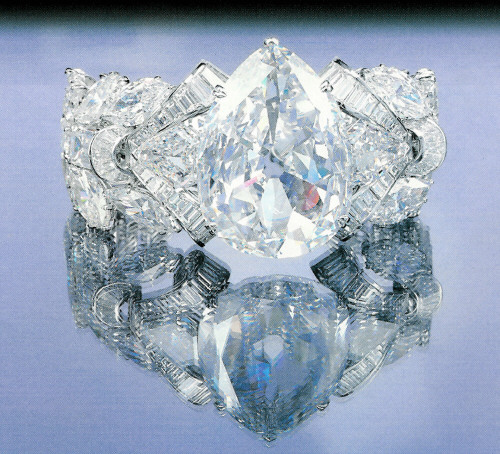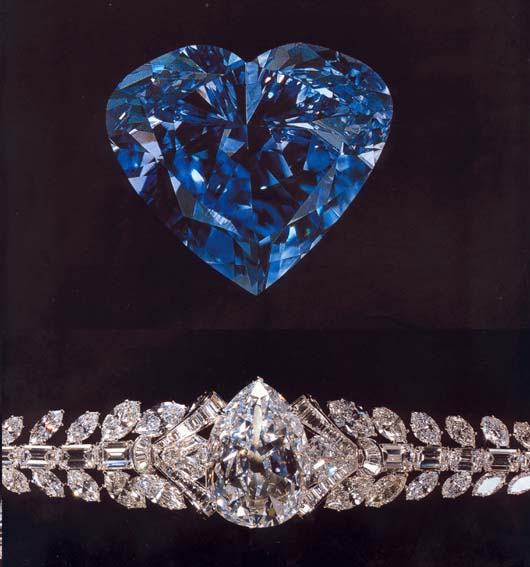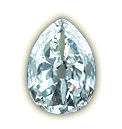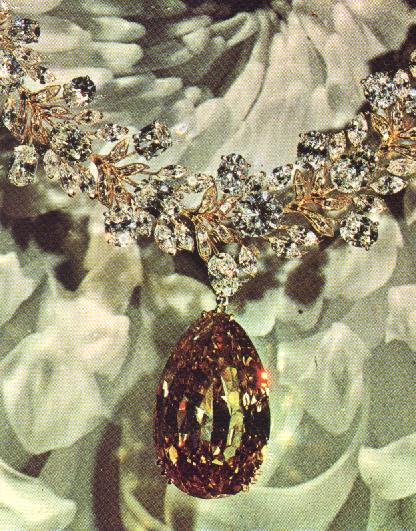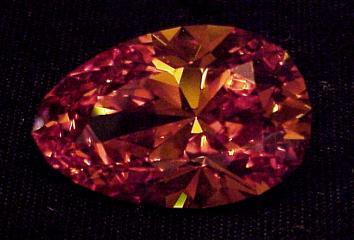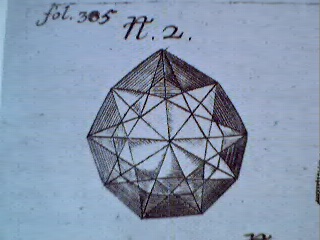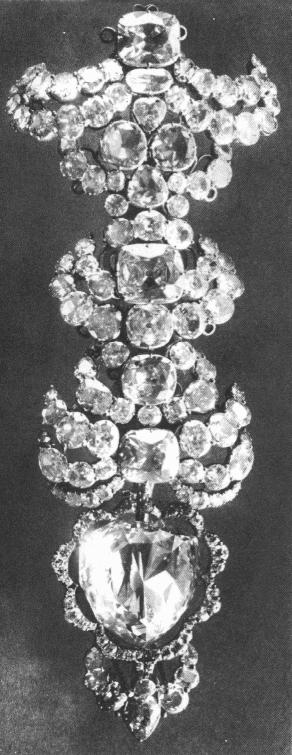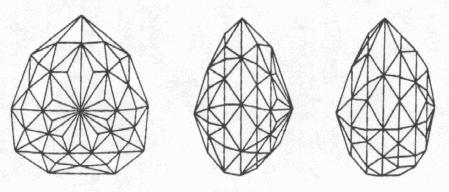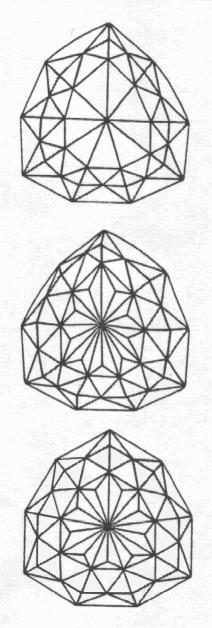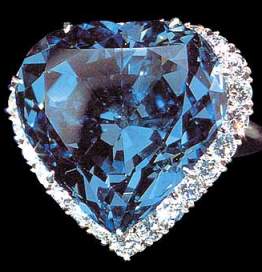Hope Diamond
The Hope Diamond is a large, 45.52 carats (9.10 g), fancy deep-blue diamond, housed in the Smithsonian Natural History Museum in Washington, D.C. The Hope Diamond is blue to the naked eye because of trace amounts of boron within its crystal structure, but it exhibits red phosphorescence under ultraviolet light It is classified as a Type IIb diamond, and is famous for supposedly being cursed.
An examination in December 1988 by the Gemological Institute of America's Gem Trade Lab showed the diamond to weigh 45.52 carats (9.104 g) and described it as "fancy dark grayish-blue." A re-examination in 1996 slightly rephrased that description as "fancy deep grayish-blue. The stone exhibits an unusually intense and strongly-colored type of luminescence: after exposure to long-wave ultraviolet light, the diamond produces a brilliant red phosphorescence that persists for some time after the light source has been switched off. The clarity was determined to be VS1, with whitish graining present. The cut was described as being "cushion antique brilliant with a faceted girdle and extra facets on the pavilion." The dimensions in terms of length, width, and depth are 25.60mm × 21.78mm × 12.00mm (1in × 7/8in × 15/32in).
Color
In popular literature, many superlatives have been used to describe the Hope Diamond as a "superfine deep blue", often comparing it to the color of a fine sapphire "blue of the most beautiful blue sapphire" As colored diamond expert Stephen Hofer points out, blue diamonds similar to the Hope can be shown by colorimetric measurements to be grayer (lower in saturation) than blue sapphires. In 1996 The Gemological Institute of America's Gem Trade Lab GIA-GTL examined the diamond and using their proprietary scale, graded it fancy deep grayish blue. Visually, the gray modifier is so dark indigo that it produces an "inky" effect appearing almost blackish-blue in incandescent light Current photographs of the Hope Diamond utilize high-intensity light sources that tend to maximize the brilliance of gemstones.
History
According to specious later accounts, the original form of the Hope Diamond was stolen from an eye of a sculpted idol of the Hindu goddess Sita, the wife of Rama, the Sixth Avatar of Vishnu. However, much like the "curse of Tutankhamun", this general type of "legend" was the invention of Western authors during the Victorian era, and the specific legends about the Hope Diamond's "cursed origin" were invented in the early 20th century to add mystique to the stoneThe first known precursor to the Hope Diamond was the Tavernier Blue diamond, a crudely cut triangular shaped stone of 115 carats 22.44 g named for the French merchant-traveler Jean-Baptiste Tavernier who brought it to Europe. His book, the Six Voyages Le Six Voyages de, contains sketches of several large diamonds he sold to Louis XIV in 1669; while the blue diamond is shown among these, Tavernier makes no direct statements about when and where he obtained the stone. The historian Richard Kurin builds a plausible case for 1653 as the year of acquisition, and an origin from the Kollur mine in Guntur district Andhra Pradesh (then a part of the Golconda kingdom), India. But the most that can be said with certainty is that Tavernier obtained the blue diamond during one of his five voyages to India between the years 1640 and 1667.
Early in the year 1669, Tavernier sold this blue diamond along with approximately one thousand other diamonds to King Louis XIV of France for 220,000 livres, the equivalent of 147 kilograms of pure gold.[13] There has been some controversy regarding the actual weight of the stone; Morel believes that the 112 3/16 carats stated in Tavernier's invoice would be in old French carats, thus 115.28 metric carats.
The French Blue
In 1678, Louis XIV commissioned the court jeweller, Sieur Pitau, to recut the Tavernier Blue, resulting in a 67 1/8 carat 13.4 g stone which royal inventories thereafter listed as the Blue Diamond of the Crown diamant bleu de la Couronne de France , but later English-speaking historians have simply called it the French Blue. It was set in gold and suspended on a neck ribbon for the King to wear on ceremonial occasions.
In 1749, King Louis XV had the French Blue set into a more elaborate jewelled pendant for the Order of the Golden Fleece, but this fell into disuse after his death. Marie Antoinette is commonly cited as a victim of the diamond's "curse", but she never wore the Golden Fleece pendant, which was reserved for the use of the king. During the reign of her husband, King Louis XVI, she used many of the French Crown Jewels for her own personal adornment by having the individual gems placed into new settings and combinations, but the French Blue remained in this pendant except for a brief exception in 1787, when the stone was removed for scientific study by Mathurin Jacques Brisson and returned to its setting soon after.
In September 1792, while Louis XVI and his family were confined in the Palais des Tuileries during the early stages of the French Revolution, a group of thieves broke into the Garde-Meuble Royal Storehouse and stole most of the Crown Jewels. While many jewels were later recovered, including other pieces of the Order of the Golden Fleece, the French Blue was not among them and it disappeared from history.
Disappearance
The Hope Diamond was long believed to have been cut from the French Blue, but this remained unconfirmed until a three-dimensional lead model of the latter was recently rediscovered in the archives of the French Natural History Museum in Paris. Previously, the dimensions of the French Blue had been known only from two drawings made in 1749 and 1789; although the model slightly differed from the drawings in some details, these details were identical to features of the Hope Diamond, allowing CAD technology to digitally reconstruct the French Blue around the recut stone.
Historians Germain Bapst and Bernard Morel suggested that one robber, Cadet Guillot, took the French Blue, the Côte-de-Bretagne spinel, and several other jewels to Le Havre and then to London, where the French Blue was cut into two pieces. Morel adds that in 1796, Guillot attempted to resell the Côte-de-Bretagne in France but was forced to relinquish it to a fellow thief, Lancry de la Loyelle, who put Guillot into debtors' prison.
Conversely, the historian Richard Kurin speculates that the "theft" of the French Crown Jewels was in fact engineered by the revolutionary leader George Danton as part of a plan to bribe the opposing military commander, Duke Karl Wilhelm of Brunswick. When under attack by Napoleon in 1805, Karl Wilhelm may have had the French Blue recut to disguise its identity; in this form, the stone could have come to England in 1806, when his family fled there to join his daughter Caroline of Brunswick. Although Caroline was the wife of the Prince Regent George, she lived apart from her husband, and financial straits sometimes forced her to quietly sell her own jewels to support her household.
Caroline's nephew, Duke Karl Friedrich, was later known to possess a 13.75 carats 2.75g blue diamond which was widely thought to be another piece of the French Blue. However, this smaller diamond's present whereabouts are unknown, and the recent CAD reconstruction of the French Blue fits too tightly around the Hope Diamond to allow for the existence of such a sister stone.
George IV
A blue diamond with the same shape, size, and color as the Hope Diamond was recorded in the possession of the London diamond merchant Daniel Eliason in September 1812, the earliest point when the history of the Hope Diamond can be definitively fixed. It is often pointed out that this date was almost exactly 20 years after the theft of the French Blue, just as the statute of limitations for the crime had expired.
Eliason's diamond may have been acquired by King George IV of the United Kingdom, There is no record of the ownership in the Royal Archives at Windsor, but some secondary evidence exists in the form of contemporary writings and artwork, and George IV tended to commingle the state property of the Royal Jewels with family heirlooms and his own personal property. After his death in 1830, some of this mixed collection was stolen by his mistress, Lady Conyngham, and some of his remaining personal items were discreetly liquidated to cover the many debts he had left behind him. In either case, the blue diamond was not retained by the British royal family.
The Hope Family
In 1839, the Hope Diamond appeared in a published catalog of the gem collection of Henry Philip Hope. The stone was set in a medallion surrounded by many smaller white diamonds, which he sometimes lent to Louisa Beresford, the widow of his brother Thomas Hope, for society balls. Henry Philip Hope died in 1839, the same year as the publication of his collection catalog. His three nephews, the sons of his brother Thomas, fought in court for ten years over his inheritance, and ultimately the collection was split up.
The oldest nephew, Henry Thomas Hope, received eight of the most valuable gems including the Hope Diamond. It was put on display in the Great Exhibition of London in 1851 and Paris Exhibition Universelle in 1855, but was usually kept in a bank vault. In 1861, his only child, Henrietta, married Henry Pelham-Clinton, Earl of Lincoln. When Henry Thomas died on December 4, 1862, his wife Anne Adele inherited the gem, but feared that the profligate lifestyle of her son-in-law (now the 6th Duke of Newcastle) might cause him to sell the Hope properties.
Upon Adele's death in 1884, the entire Hope estate, including the Hope diamond, was entailed to Henrietta's younger son, Henry Francis, on the condition that he change his surname when he reached legal majority. As Lord Henry Francis Hope Pelham-Clinton Hope, this grandson received his legacy in 1887. However, Francis had only a life interest to his inheritance, meaning he could not sell any part of it without court permission.
On November 27, 1894, Lord Francis married his mistress, American actress May Yohe. She later claimed she had worn the diamond at social gatherings (and had an exact replica made for her performances), but he claimed otherwise. Lord Francis lived beyond his means, and it eventually caught up with him. In 1896, his bankruptcy was discharged, but, as he could not sell the Hope Diamond until he had the court's permission, his wife supported them. In 1901, he was free to sell the Hope Diamond, but May ran off with Putnam Strong, son of former New York City mayor William L. Strong. Francis divorced her in 1902.
Lord Francis sold the diamond for £29,000 to Adolph Weil, a London jewel merchant. Weil later sold the stone to U.S. diamond dealer Simon Frankel, who took it to New York. There, it was evaluated to be worth $141,032 (equal to £28,206 at the time). In 1908, Frankel sold the diamond for $400,000 to a Salomon or Selim Habib, reportedly in behalf of Sultan Abdul Hamid of Turkey; however, on June 24, 1909, the stone was included in an auction of Habib's assets to settle his own debts, and the auction catalog explicitly stated that the Hope Diamond was one of only two gems in the collection which had never been owned by the Sultan. The Parisian jewel merchant Simon Rosenau bought the Hope Diamond for 400,000 francs and resold it in 1910 to Pierre Cartier for 550,000 francs.
Cartier, McLean, and Winston
Pierre Cartier first offered the Hope Diamond to U.S. socialite Evalyn Walsh McLean in 1910. She initially rejected the stone in the Hope family's old setting, but she found the stone much more appealing when Cartier reset it in a more modern style and told elaborate stories about its supposed "cursed" origins. Eventually, McLean bought the new necklace and afterwards wore it at every social occasion she organized. When she died in 1947, she willed the diamond to her grandchildren, though her property would be in the hands of trustees until the eldest had reached 25 years of age, which would have meant at least 20 years in the future. However, the trustees gained permission to sell her jewels to settle her debts, and in 1949 sold them to New York diamond merchant Harry Winston.
Over the next decade, Winston exhibited McLean's necklace in his "Court of Jewels," a tour of jewels around the United States, as well as various charity balls and the August 1958 Canadian National Exhibition. At some point, he also had the Hope Diamond's bottom facet slightly recut to increase its brilliance. He donated it to the Smithsonian Institution on November 10, 1958, sending it through U.S. Mail in a plain brown paper bag. Winston never believed in any of the tales about the curse and died of a heart attack at the age of 82 on December 28, 1978.
The Smithsonian Institution
For its first four decades in the National Museum of Natural History, the Hope Diamond lay in its necklace inside a glass-fronted safe as part of the gems and jewelry gallery, except for a few brief excursions: a 1962 exhibition in the Louvre; the 1965 Rand Easter Show in Johannesburg, South Africa; and two visits back to Harry Winston's premises in New York City for a 50th anniversary celebration in 1988 and some minor cleaning and restoration in 1996.
When the Smithsonian's gallery was renovated in 1997, the necklace was moved onto a rotating pedestal inside a cylinder made of 3-inch (76 mm) thick bulletproof glass in its own display room, adjacent to the main exhibit of the National Gem Collection in the Janet Annenberg Hooker Hall of Geology, Gems, and Minerals. The Hope Diamond is the most popular jewel on display.
On February 9, 2005, the Smithsonian Institution published the findings of its year-long computer-aided geometry research on the gem and officially acknowledged the Hope Diamond is part of the stolen French Blue crown jewel.
MNHN in Paris
On November 2008, the Muséum national d'Histoire naturelle published a bilingual French/English press release [18] about the discovery of a unique and previously unknown lead cast of the French Blue diamond in the MNHN gemmological collections in Paris, and the resulting investigation by an international group of researchers. Compared to the previously available drawings, the model showed numerous unsuspected facets and corrected the actual thickness of the stone, leading to CAD analysis and the creation of the first numeric reconstruction of the French Blue
The emblem of the Golden Fleece of Louis XV was numerically reconstructed around the French Blue, including the "Côte de Bretagne" spinel of 107 carats 21g, the "Bazu" diamond of 32.62 carats (6.52 g), 3 oriental topazes (yellow sapphires), five 4-5 carats (1,000 mg) brillants and nearly 300 smaller diamonds. Special care was taken to reconstruct the major gemstones from CAD analysis and knowledge of historical gemsetting techniques.
As part of the investigation, the "Tavernier Blue" diamond was also reconstructed from the original French edition of Tavernier's Voyages (rather than the later London edition that somewhat distorted and modified Tavernier's original figures), and the Smithsonian Institution provided ray-tracing and optical spectroscopic data about the Hope diamond.
The lead cast of the French Blue along with a lead model of the Mirror Of Portugal diamond had been given to the museum in 1850 by Charles Archard, a prominent jeweler in Paris at that time. The model was accompanied by a label stating that the stone was in the possession of "Mr. Hoppe of London".
The MNHN in Paris commissioned the first exact cubic zirconia replicas of Tavernier and French Blue diamonds from lapidary Scott Sucher. These replicas have been completed and are currently on view together with the French Crown jewels and the Great Sapphire of Louis XIV, a fantastic Moghol-cut sapphire of 135.7 carats (27.1 g).
The Curse
An early account of the Hope Diamond's "cursed origins" was a fanciful and anonymously written newspaper article in The Times on June 25, 1909. However, an article entitled "Hope Diamond Has Brought Trouble To All Who Have Owned It" had appeared in the Washington Post on January 19, 1908.
A few months later, this was compounded by the New York Times on November 17, 1909, which wrongly reported that the diamond's former owner, Selim Habib, had drowned in a shipwreck near Singapore; in fact, it was a different person with the same name, not the owner of the diamond. The jeweller Pierre Cartier further embroidered the lurid tales to intrigue Evalyn Walsh McLean into buying the Hope Diamond in 1911.
According to these stories, Tavernier stole the diamond from a Hindu temple where it had been set as one of two matching eyes of an idol, and the temple priests then laid a curse on whoever might possess the missing stone. One reason that this is not accepted is the other blue diamond "eye" has never surfaced. Furthermore, the legend claimed that Tavernier died of fever soon after and that his body was torn apart by wolves, but the historical record shows that he actually lived to the age of 84.The Hope Diamond was also blamed for the unhappy fates of other historical figures vaguely linked to its ownership, such as the falls of Madame Athenais de Montespan and French finance minister Nicolas Fouquet during the reign of Louis XIV of France; the beheadings of Louis XVI and Marie Antoinette and the rape and mutilation of the Princesse de Lamballe during the French Revolution; and the forced abdication of Turkish Sultan Abdul Hamid who had supposedly killed various members of his court for the stone.
Even the jewelers who may have handled the Hope Diamond were not spared from its reputed malice: the insanity and suicide of Jacques Colot, who supposedly bought it from Eliason; the financial ruin of the jeweler Simon Frankel, who bought it from the Hope family. But although he is documented as a French diamond dealer of the correct era, Colot has no recorded connection with the stone, and Frankel's misfortunes were in the midst of economic straits that also ruined many of his peers.
The legend further includes the deaths of numerous other characters who had been previously unknown: diamond cutter Wilhelm Fals, killed by his son Hendrik, who stole it and later committed suicide; Francois Beaulieu, who received the stone from Hendrik but starved to death after selling it to Daniel Eliason; a Russian prince named Kanitowski, who lent it to French actress Lorens Ladue and promptly shot her dead on the stage, and was himself stabbed to death by revolutionaries; Simon Montharides, hurled over a precipice with his family. However, the existence of only a few of these characters has been verified historically, leading researchers to conclude that most of these persons are fictitious.
The actress May Yohe made many attempts to capitalize on her identity as the former wife of the last Hope to own the diamond, and sometimes blamed the Hope for her misfortunes. In July 1902, months after Lord Francis divorced her, she told police in Australia that her lover, Putnam Strong, had abandoned her and taken her jewels. Incredibly, the couple reconciled, married later that year, but divorced in 1910. On her third marriage by 1920, she persuaded film producer George Kleine to back a 15-episode serial The Hope Diamond Mystery, which added fictitious characters to the tale. It was not successful. In 1921, she hired Henry Leyford Gates to help her write The Mystery of the Hope Diamond, in which she starred as Lady Francis Hope. The film added more characters, including a fictionalized Tavernier, and added Marat among the diamond's "victims". She also wore her copy of the Hope, trying to generate more publicity to further her career.
Lord Francis Hope married Olive Muriel Thompson in 1904. They had three children before she died suddenly in 1912, a tragedy that has been attributed to The Curse.
Evalyn Walsh McLean added her own narrative to the story behind the blue jewel, including that one of the owners was Catherine the Great. McLean would bring the Diamond out for friends to try on, including Warren G. Harding and Florence Harding. McLean often strapped the Hope to her pet dog's collar while in residence at Friendship. There are also stories that she would frequently misplace it at parties, and then make a children game out of finding the Hope.
However, since the diamond was put in the care of the Smithsonian Institution, there have been no unusual incidents related to it.




